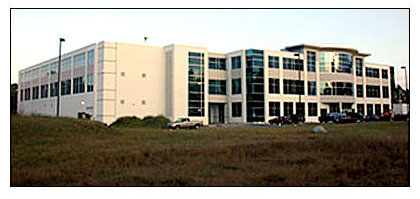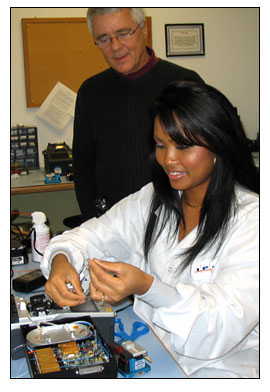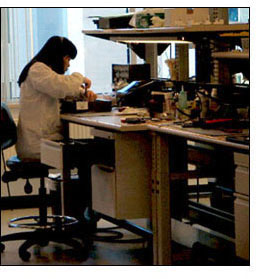
IPG Photonics Turned Fiber Bust Into Laser Boom
OXFORD, Mass., Jan. 6, 2006 -- IPG Photonics Corp.'s world headquarters is striking yet understated. Set back from a sparsely populated but well-trafficked industrial route in Oxford, Mass., on 62 acres -- about 12 miles from Worcester in an area once referred to as the fiber optic capital of the world -- three contemporary, white three-story structures house the company's engineering, research and development, component testing, manufacturing, sales, customer support and executive offices. (Driving south on Old Webster Road, if you pass a Jehovah's Witnesses church on the left, you've missed IPG Photonics' driveway.)
 |
IPG Photonics world headquarters, in Oxford, Mass. (Photo: IPG Photonics)
|
But there's nothing humble about the company's ability to develop markets for its fiber lasers and amplifiers, although it does take pains to keep its technology under wraps.
Dennis Leonard, vice president of operations, leads a tour of the facility with low-key but apparently boundless enthusiasm, through hallways adorned with international travel posters. The surroundings have a jovial air of industriousness as Leonard leads visitors around "cube farms," directs them past windows revealing clean rooms where white-jacketed men and women assemble electronic components, or escorts them into a shop where technicians test fiber laser systems.

Dennis Leonard, vice president of operations, with Frederick Baird, electromechanical technician. (Photo: Photonics.com)
IPG Photonics makes amplifiers for telecommunications and fiber lasers for marking, the printing industry and material processing; free-space applications; laboratory and medical applications; test instruments; and other industrial applications. Oxford is its base for engineering, high-volume manufacturing and component testing for North and South American customers, and the company is in the process of expanding to a 50,000-square-feet-addition on the site to handle more laser manufacturing employees. (The US headquarters mirrors IPG's much larger engineering, R&D and production facilities in Germany.)
A trailer docked in a bare courtyard, between the existing buildings (built in 2001) and the new addition, is serving as a temporary employee cafeteria. Inside the addition, a construction crew works near a huge, basement laboratory with freshly painted, canary-yellow floors -- a color chosen to keep employees' moods elevated in the windowless area, Leonard said.
Bill Shiner, director of industrial market development at IPG Photonics, is equally enthusiastic about IPG's fiber-based amplifiers, lasers, transmitters and other products, which are designed and sold to communications and technology companies throughout the world.
They have grounds for enthusiasm: Sales for the first half of 2005 increased by 58 percent, and the company's net income was up by over 200 percent, compared with the same period in 2004. It attributes this growth to increased sales of its industrial, medical and telecom products.
"In the second half of 2005, the company expects continued strong financial performance with annual revenue of over $90 million," said IPG Photonics' CFO Tim Mammen in November.

IPG Photonics began operating in the US in December 1998 as a member of IPG Group (IRE-Polus Group), dedicated to developing high-power optical subsystems. Valentin P. Gapontsev founded the IPG Group with the creation of NTO IRE-Polus in Russia in 1990. Gapontsev's expertise is in nonradiative energy transfer in rare earth ions and solid-state materials; he has a PhD in physics from the Moscow Institute of Physics and Technology and is the author of numerous scientific articles. The IPG Group includes IPG Photonics, IPG Laser GmbH (Germany), IPG Fibertech SRL (Italy) and affiliated companies in Fryazino, Russia and in the UK.
IPG Photonics is now the parent company and world headquarters for IPG.
In 2000, IPG obtained $100 million in venture financing and completed a worldwide reorganization, making IPG Photonics, a Delaware corporation, the new parent company of several related companies owned by Gapontsev. That year, 87 percent of it sales were in lasers, amplifiers and transmitters to telecoms such as Siemens, Bosch Telecom and Lucent. But the telecom crash forced it to find new markets. (In 2001, IPG Photonics also withdrew its application for an initial public offering. Mammen said the company currently is undecided about whether to go public in the future.)

Srey Chea, training coordinator, demonstrates fiber splicing for Bill Shiner, director of market development at IPG Photonics. (Photo: IPG Photonics)
Gapontsev -- who worked as a researcher in the Russian Academy of Sciences before moving to the US -- devised a new type of high-powered, mobile and more stable laser that, as it turned out, had unexpected applications (which are still being discovered, Shiner said).
In 2001, it also made a crucial decision to manufacture laser diodes, which are used as the pump source for their fiber lasers and amplifiers. Previously, the company had bought its diodes from a US-based contract manufacturer.
"The diodes are the highest-cost item in our lasers," Shiner said. "Investing over $20 million in a diode factory drove costs down tremendously and allowed us to price lower than our competitors. Single-emitter diodes are the key to our success."
But it's "not just beating the competition," he insists. "We want to maker lasers more affordable. Our goal is to expand the market for the utilization of lasers in manufacturing."
IPG sold over 3000 fiber lasers last year, he said. Its inventory of fiber lasers includes high- and low-power erbium (Er), ytterbium (Yb), thulium (Tm), Raman and visible continuous wave (CW), Q-switched, tunable, polarized, single-frequency lasers; its amplifiers include Yb, Er, Tm, neodymium (Nd) and Raman models; its fiber-delivered direct diode systems are available in the 960 to 970 nm and 20 to 10,000 watt ranges.
The company carries more than 300 proprietary active and specialty passive fibers, and more than 60 proprietary active and passive fiber-pigtailed functional components including electro-optic modulators, acousto-optic modulators, isolators, filters and gratings. It boasts a proprietary fiber beam-combining technique and kW-class beam delivery fibers, and manufactures complete laser systems for industrial, aerospace, automotive, shipbuilding, printing, 3-D modeling, marking, engraving, microelectronic, computer, telecommunications, medical, scientific and government applications.
For example, Shiner said, IPG has shipped a fiber laser that was installed in a US military Humvee and was deployed to the Middle East. In that application, a telescope is used to expand a laser beam, allowing the laser to detonate a land mine up to 300 yards away. The company also recently submitted a quote for a 400-kW system to create gas from solid material on the ocean floor.
IPG announced in November it was supplying a 10-kW continuous-wave ytterbium fiber laser system under a commercial procurement contract awarded by the US Naval Surface Warfare Center in Crane, Ind. The water-cooled YLR-10000, with a central emission wavelength of 1070 nm, delivers output through a 20-m flexible fiber. Its subsidiary IPG Laser GmbH recently installed a diode-pumped 20-kilowatt ytterbium fiber laser system in Berlin under a contract award from BAM (Bundesanstalt fur Materialforschung und-prufung/the German Federal Institute for Materials Research & Testing), the national materials and chemicals technological institute of Germany, to use in materials processing research on alloys and steel.
"The installation at BAM signals that IPG is opening doors to new challenges in materials processing," Valentin Gapontsev said in a press release in October.
Although the company supplies high-power lasers to the government, they are standard industrial lasers. IPG is also a large supplier to a variety of defense contractors and government laboratories, for which it provides systems to specification.
Shiner said more and more industrial manufacturers are taking notice of fiber laser systems for cutting, welding, drilling and marking applications.
"Fiber laser systems are more reliable, cost-effective and efficient than traditional technologies, and are now replacing CO2 and YAG lasers for marking, welding, cutting and engraving applications," he said. These include welding, gas and oil industry uses, drilling, telecom amplifiers, medical procedures and dermatology. IPG uses single-emitter diodes, rather than diode bars, to pump its fiber lasers; this provides diode life beyond 100,000 hours of operation. Shiner said other companies have come to realize this is the best approach.
He said fiber lasers "can do any kind of welding or cutting. First, sales have been for single-purpose, dedicated machines. In the future, fiber lasers will be justified for welding and cutting with the same laser. There is no other technology that can easily do that. Another growth area is five-axis cutting and welding, where the fiber laser will eliminate a very costly compound cutting or welding head."

Michael Barootkoob, telecommunications technician (Photo: Photonics.com)
He said the company also does a lot of nonmetal cutting with fiber lasers, "but it can't do all nonmetals, like papers. There will always be CO2 lasers for some nonmetal cutting applications. But we're doing automotive bumpers, for example, made from composite plastic that cuts better than C02, so it really depends on the application."
IPG Photonics is "number one in marking in Japan," where Sun-x Corp., a maker of turnkey marking systems, is its No. 1 OEM customer, Shiner said.
"Remote welding is a key area where fiber lasers have begun to make an impact in the auto industry," he said. "Fiber lasers, with their long working distance and ease of integration, are ideally suited to welding auto bodies at high rates of speed." (See a video of an IPG Photonics fiber laser in an automotive application: www.photonics.com/images/features/ipgremotelaser.wmv (IPG 5-kW fiber laser with a two-meter focal length lens simulating remote welding of car bodies; 6.1 MB, .wmv [Windows Media Video] format)
"We have about a 39-percent market share in the Japanese marking market," Shiner said. "In the US, IPG has 15 OEMs who have switched to fiber lasers, because they're maintenance-free, very compact and very inexpensive. When the prices came down, they became an attractive way to go."
Another application for fiber lasers is to set the contact pressure on disk drive flexures.
"IPG shipped over 200 lasers last year to computer manufacturers for this application," Shiner said. "They use the laser to set the contact pressure. We have four companies that manufacture hard disk drives that purchase our lasers."
IPG's global approach is evident throughout its facilities; Shiner calls the work force "a regular United Nations." (Of its 700 employees worldwide, about 250 work in Oxford, and 18 percent have advanced degrees, including 60 PhDs. "Valentin goes out of his way to attract real world-class scientists," Shiner said. "When telecom went downhill, Valentin had the foresight to redirect the technical staff to the development of fiber lasers.")
But that international viewpoint has its limits, for instance, in regard to outsourcing manufacturing.
Mammen said, "A lot of people have chosen to outsource or put their manufacturing in China, in low-cost labor environments. Dr. Gapontsev is not in favor of doing that, because he doesn't want to release proprietary technology. So we've chosen to keep all the manufacturing and all the critical stuff in Germany and the US."
He added, "We have fairly significant labor content, but it doesn't unduly impact gross margins. For us, it's not prohibitively expensive, relative to labor content within our devices. And we view it as more risky and potentially damaging over the long term to subcontract."
IPG's labor percentage is "an ever changing number," Mammen said. "As we have driven down the costs of components, the percentage inevitably climbs up; at the moment we're at 23-percent average total labor."

Kim Mong, optical assembler (Photo: Photonics.com)
IPG has an "extremely loyal" core group of people, Mammen said, which extends to the lower ranks of its workforce and is reflected by an extremely low turnover rate.
Employees operate strictly on a need-to-know basis, Leonard said. "Laser diode engineers are separated from telecommunications product engineers, and only a very small percentage of people have access to the assembly and fiber block area. The whole idea is limited access."
To enhance its work force, IPG often recruits staff from fiber-based industries and other laser industries in the area. For example, Leonard said, "We have a number of engineers and technicians from several of the larger laser companies."
IPG also invests heavily in training both its employees and its future work force. Splicers undergo two-week training in the fundamentals of fiber management and basic electronics before they're considered for full-time positions. ("Splicing is a key part of our technology," Leonard said.)
It also sponsors internships at area schools (Springfield Technical Community College, in Springfield, Mass; Quinsigamond Community College, in Worcester; and Three Rivers Community College in Norwich, Conn.), and is a prime employer of local technical college graduates. The company also has a hand in local occupational high-school curricula and sponsors internships such as in-house two-week training sessions for teachers.
IPG was also involved in Project Photon, an outgrowth of earlier projects of the New England Board of Higher Education, which prepared New England middle school, secondary school and post-secondary educators and career counselors from 36 different institutions to introduce photonics education into the classroom.
The company is also committed to professional development. Shiner was recently instrumental in forming a New England chapter of the Laser Institute of America (LIA) that will include end users, laser operators and scientists, covering Sturbridge, Boston, Hartford and New Haven. As a result of its success, he said, LIA is now forming similar local chapters in Detroit and California.
For more information, visit: www.ipgphotonics.com
IPG Photonics
50 Old Webster Road
Oxford, MA. 01540 USA
Phone: (508) 373-1100
Fax: (508) 373-1103
/Buyers_Guide/IPG_Photonics_Corporation/c7101